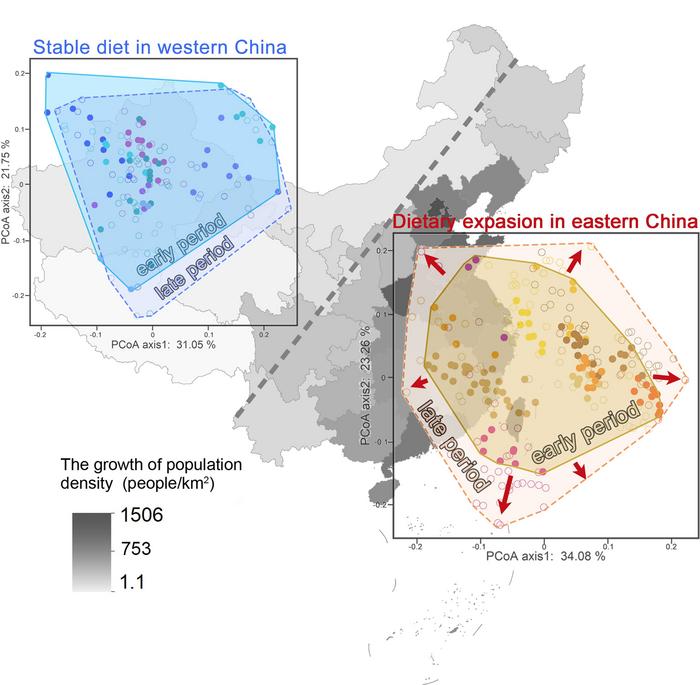The human population explosion, soaring from 1.6 billion to over 6 billion during the 20th century, has had a profound impact on global environments and biodiversity. However, large mammalian herbivores, including species such as elephants and deer that are sensitive to habitat changes, have experienced relatively little extinction in the face of this 20th century change. To investigate why this otherwise sensitive group of mammals has survived during this part of the Anthropocene, a research team of scientists examined the diets of the most common large-bodied herbivorous mammals weighing over 20 kg (44 lbs) across China over the past century.

Credit: IVPP
The human population explosion, soaring from 1.6 billion to over 6 billion during the 20th century, has had a profound impact on global environments and biodiversity. However, large mammalian herbivores, including species such as elephants and deer that are sensitive to habitat changes, have experienced relatively little extinction in the face of this 20th century change. To investigate why this otherwise sensitive group of mammals has survived during this part of the Anthropocene, a research team of scientists examined the diets of the most common large-bodied herbivorous mammals weighing over 20 kg (44 lbs) across China over the past century.
“The species we focused on in this study currently have considerable population sizes and have skillfully adapted to our changing planet. Many previous studies concentrated on how species that have gone extinct or are on the brink of extinction could not adapt to significant environmental changes. By turning our attention to these ‘success stories’ instead, we aim to understand how species can and have adapted to a human-dominated planet. This insight provides invaluable experience to help ensure that more species can coexist with humans into our shared future,” said Dr. YANG Yangheshan of East China Normal University (ECNU), lead author of the study.
The diverse group of collaborating researchers from several institutions led by scientists from ECNU and the Institute of Vertebrate Paleontology and Paleoanthropology (IVPP) of the Chinese Academy of Sciences published their findings in Ecology Letters.
Dr. Thomas Stidham of IVPP said that in order to understand how diets may have changed, “Our research team documented and analyzed the diversity of details of dental microwear, which are microscopic pits, scratches, and other damage preserved on the surfaces of the teeth of large plant-eating mammals. This microwear damage correlates to their diets with the different kinds of plants eaten resulting in different types and amounts of damage accumulated on the tooth surfaces.”
The team collected data from 380 lower jaw specimens, spanning 18 species of large herbivorous mammals in China, covering the time before (1880s–1910s) and after (1970s–1990s) the human population explosion. They expressed hope that other researchers would apply this approach in studying past and ongoing diet shifts in mammals around the world.
Statistical analysis of the hundreds of mammalian teeth from across the 20th century revealed significant dietary changes in eastern China, east of the Hu-line, where the majority of the population increase occurred. In contrast, western China, covering approximately 57% of mainland China’s land and inhabited by only 6% of its population, showed minimal directional changes in large mammal diets over the same period.
Their results are very telling: Whereas mammalian diets remained similar over time in western China with its lowered population growth, the diets of large herbivores in eastern China—which experienced rapid industrialization and a population boom—showed a significant shift in their plant diets over the same time period. This shows that large mammals survived dramatic human-driven changes into land use and occupation in eastern China by altering their diets. Further functional diversity analysis suggests that the primary changes in the diets of eastern China’s herbivores are reflected in increased interspecific differences and expanded intraspecific dietary ranges. This implies a broader variety of food consumption compared to pre-Anthropocene times. Additionally, these increments in interspecific differences and intraspecific dietary expansion are significantly correlated with human population growth and land-use changes in the areas where the specimens were collected.
This key discovery demonstrates an undeniable link between herbivore dietary shifts and the sweeping human-induced land-use transformations in China. As humans reshaped the land for agriculture, industry, and habitation, these large herbivores altered their diets in a bid for survival.
“Our findings are a testament to the incredible adaptability of these herbivores. Confronted with the relentless march of human progress, they changed their dietary strategies, and this flexibility is possibly a cornerstone of their resilience in this rapidly changing landscape,” said Prof. SI Xingfeng of ECNU, corresponding author of the study.
As the world faces challenges in the Anthropocene era, a deeper understanding of these subtle ecological shifts becomes paramount for better conservation and preservation of the planet’s rich tapestry of life.
This study not only enhances our understanding of the delicate dance between large herbivores and their ever-evolving environment, but also offers invaluable insights into future conservation strategies.
Journal
Ecology Letters
DOI
10.1111/ele.14343
Method of Research
Experimental study
Subject of Research
Not applicable
Article Title
Uncovering widespread Anthropocene dietary shifts in Chinese large mammalian herbivores
Article Publication Date
9-Dec-2023




